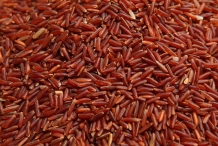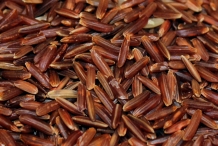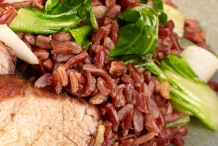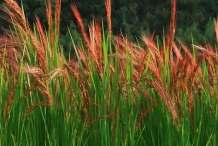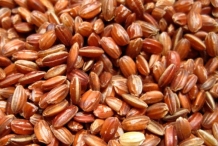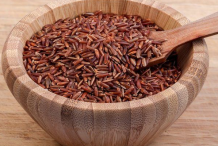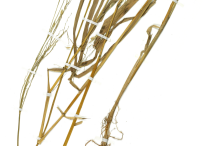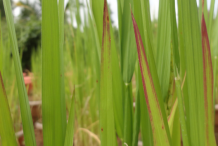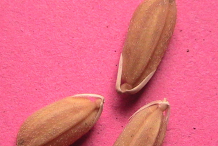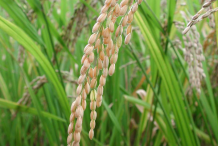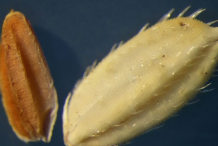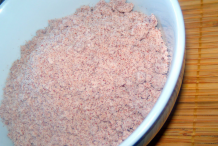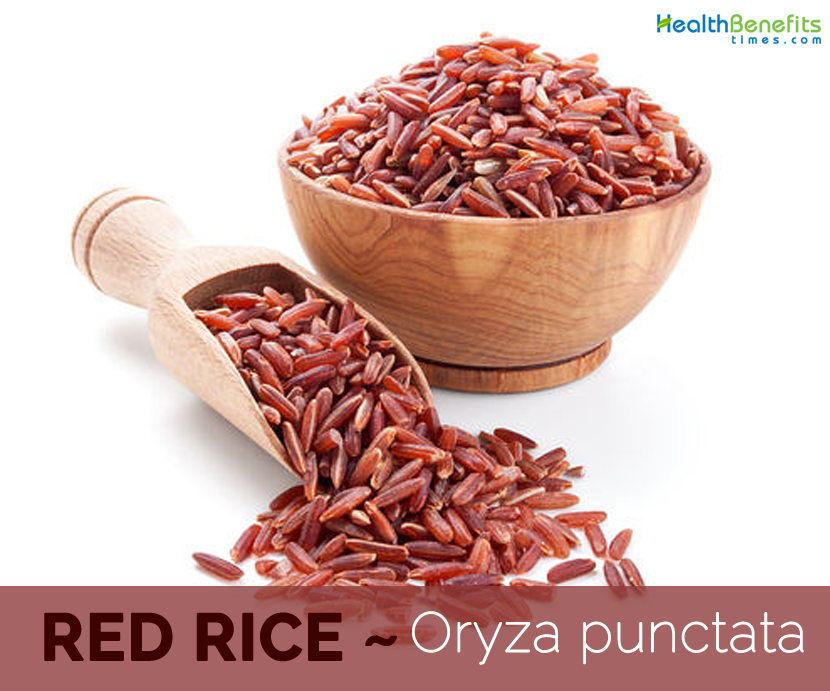
A variety of rices are known as “
red rice”. Generally, individuals mean an unhulled or partially hulled rice that includes a red husk, as opposed to the a lot more common brown. Just like other unhulled rices, red rice includes a nutty flavor, along with a higher nutritional value, thanks to the proven fact that the germ of the rice is left intact.
Several specialty stores carry red rice, frequently defined as “Bhutanese red rice” or even “cargo rice,” not to be confused with basmati rice also it can even be bought through companies that concentrate on rice.
Red rice is a common favorite, especially among the regular white rice eaters that are looking for a much healthier alternative. Red rice, is, after all, one of the purest and the richest in some of the essential nutrients that are needed for the body.
That said, in addition to browsing through Newport Natural Health News, if you’re interested in learning more about this healthier staple option of whole grains, keep reading through below. Here, you’ll come face-to-face with the health benefits that red rice can bring.
A Brief Background On Red Rice
However, “red rice” may also make reference to a wild variety of rice that features a low grain yield, leading numerous rice farmers in the indigenous Asia to regard it as a weed. This kind of red rice become a genuine nuisance alongside rice plantations, since it can cross-breed, producing inferior rice plants, also it can take over. Numerous attempts have been made to genetically modify this rice varietal to really make it more beneficial. The word “red rice” is additionally sometimes utilized to make reference to red yeast rice, a specialized product produced in China and Japan. To make red yeast rice, manufacturers hull and polish rice grains and after that cultivate a mold that results in a crusty red coating. This particular rice could be consumed such as frequent rice; however it is also utilized in Traditional Chinese Medicine to deal with a number of conditions. Research on red yeast rice also seem to claim that it may help combat dangerous cholesterol levels.
Assuming one is not talking about a weed in order to red yeast rice, red rice is available in a number of forms. Several cultivars are short grained and are incredibly sticky, while some are long-grained. Red rice is cultivated in Europe, Southeast Asia, and also the American South, and a few companies have developed their own cultivars by cross-breeding several varieties.
Whenever red rice is cooked, the natural red colorization within the bran, or hull of the rice, leaches out and dyes the rest of the dish red to pink. Red rice has lots of fiber, due to the bran, and flavor is significantly more powerful compared to hulled rice, tasting more nutty and full. Red rice works well with a number of foods and also eaten by itself, also it can be included in risotto and other combined rice dishes too. That’s why red rice is now considered a very healthy kind of whole grain.
There are thousands of varieties of rice around the world among them rice with red bran layer are known as red rice. The re color of the rice bran ranges from light to dark. The red bran layer contains 95% of the minerals and dietary fiber of the whole rice which contains Iron, Zinc Potassium Sodium, Manganese and so forth. The inner white portion contains predominantly carbohydrate and proteins.
Nutritional value of Red Rice
Serving Size: 100 g
Calories 405 Kcal. Calories from Fat 44.10 Kcal.
| Red rice Quick Facts |
| Name: |
Red rice |
| Scientific Name: |
Oryza punctata |
| Origin |
Tropical Africa, South Africa, and Madagascar |
| Colors |
Red, light-red, dark-red, light-pink-red |
| Shapes |
Length: 3.07 - 4.01mm
Breadth: 1.05 - 2.01 mm |
| Taste |
Delicious earthy taste |
| Calories |
405 Kcal./cup |
| Major nutrients |
Iron (68.75%)
Carbohydrate (66.69%)
Zinc (30%)
Protein (14%)
Fat (14%)
Fiber (7.11%)
Potassium (5.45%) |
| Health benefits |
Contains antioxidants to counteract free radicals, Containing Vitamin B6, Can Lower High Cholesterol, Can Help Prevent Heart Disease, Can Lower Blood Glucose, It lowers the risk of obesity, helps in fighting asthma, fortified with powerful antioxidants, good for your bone health, rich in fiber |
| Proximity |
Amount |
% DV |
| Energy |
405 Kcal (1695 KJ) |
ND |
| Protein |
7 g |
14.00% |
| Total Fat (Lipid) |
4.9 g |
14.00% |
| Carbohydrate |
86.7 g |
13.55% |
| Total dietary Fiber |
2.7 g |
7.11% |
| Water |
1.6 g |
ND |
| Ash |
3.4 g |
ND |
| Minerals |
Amount |
% DV |
| Iron, Fe |
5.5 mg. |
68.75% |
| Zinc, Zn |
3.3 mg. |
30.00% |
| Potassium, K |
256 mg. |
5.45% |
| Sodium, Na |
6 mg. |
0.40% |
*Percent Daily values are based on 2,000 calorie diet. Your daily values may be higher or lower depending on your calorie needs.
Health benefits of Red Rice
Red rice is a kind of unpolished rice which has higher nutritional value compared to white rice or even polished rice. Cooking time is comparatively more than white rice and it has a nutty taste and more gratifying flavor. It is fiber rich content, Vitamin B1 & B2, iron and calcium. Because of higher nutritive content and health advantages of red rice, it is strongly advised for heart patients as well as diabetics. Additionally it is loved by health gurus as well as fitness fanatics since it’s high fiber content helps gain less weight. By consuming red rice, you can get the following nutrition and also health advantages.
1. Contains antioxidants to counteract free radicals
Red/brown rice is a great source of iron or manganese. Mangan, who was simply instrumental in producing energy for the body is a vital element of the enzyme and is also an anti-oxidant that may safeguard the body from free-radicals which are formed once the energy produced. Additionally, red/brown rice is full of zinc, a mineral that can help accelerate wound healing and maintain the body’s defense mechanisms to function effectively. Just like iron or manganese, zinc is additionally full of anti-oxidants that safeguard the body from free-radicals that may damage tissues and cells within the body.
2. Containing Vitamin B6
By consuming only one serving of red/brown rice, can meet 23 percent of vitamin B6, the quantity required for the functioning of the organ. This particular vitamin is required to help balance the development of serotonin, red blood cells helping the creation of DNA cells.
3. Can Lower High Cholesterol
In 1970, human studies reported red rice’s effect on reducing the blood levels of total cholesterol. The active component in red rice is monacolin K. It’s just like lovastatin within the prescription drug cholesterol-lowering drug, Mevacor. In accordance with EMedtv, the United States Food and Drug Administration has ruled that simply because lovastatin is really a prescription drug, any red yeast rice supplement with a substantial dosage of lovastatin is surely an unapproved drug and not a dietary supplement. Do not take red rice in case you have liver disease, are pregnant, or are younger than 18. Side effects consist of gas, heartburn and dizziness.
4. Can Help Prevent Heart Disease
Higher amounts of low-density lipoprotein or LDL in the blood cause plaque build-up in the walls of the arteries. This particular narrows the size of the arteries and could block the coronary artery, causing a heart attack. Reducing LDL cholesterol levels reduces the chance of heart disease. A 2009 study carried out by David Becker and Ram Gordon, cardiologists at Chestnut Hill Hospital reported that LDL cholesterol levels reduced more in patients receiving red yeast rice compared to patients getting a placebo.
When your LDL or bad cholesterol levels are controlled, your heart health also improves. Your chances of contracting cardiovascular problems become slim. This is a very good thing since heart-related problems can be fatal.
5. Can Lower Blood Glucose
Uncontrolled blood glucose levels in diabetics can ruin the eyes, kidneys and also the coronary heart. Controlling blood sugar levels reduces these dangers. In a animal research carried out at the Department of Food Science at the National Pingtung University of Science and Technology, Hon-Qi–a form of red yeast rice–was administered to induced-diabetic rats and also to rats with normal blood glucose levels. This was a try to create a new replacement for dealing with diabetes. The results claim that oral administration of Hon-Qi may reduce blood glucose in diabetic rats inadequate insulin.
6. It lowers the risk of obesity
Red rice will help you decrease the desire to eat and may cause you to feel fuller for the really long time. Moreover, red rice provides energy in your body and helps the digestion. Red rice is completely fat-free. Most likely you know that high-fat consumption boost the chance of obesity. It’s been shown that individuals who eat red rice on a daily basis, have got a reduce chance of obesity. In case you are attempting to drop a few unwanted pounds, eating red rice could make the method simpler.
7. It helps in fighting asthma
Since red rice is a superb source of magnesium, which will help to manage your normal breathing pattern, consuming red rice regularly will assist you to avoid the issue of asthma. This really is among the best advantages of eating red rice. If you suffer from asthma, talk to your doctor and discover whether you can consume red rice or not.
8. It’s fortified with powerful antioxidants
Red rice is additionally loaded with effective anti-oxidants which are extremely therapeutic for the skin. Consuming red rice frequently might help avoid the appearance of fine lines and wrinkles on the skin. Plus, red rice may help firm and tighten the skin and minimize the damage brought on by UV rays that may result in wrinkles.
9. Red rice is good for your bone health
As we mentioned above, red rice is a superb source of magnesium, that is ideal for your bone health. Magnesium is a crucial nutrient needed to build healthy bones and magnesium deficiency can result in osteoporosis and low bone density later in life. It has been verified that regular consumption of red rice will help avoid and relieve joint problems.
10. It’s rich in fiber
Red rice is really a whole grain to help you meet your daily fiber requirements. One-quarter cup of red rice consists of about 2 grams of fiber, and it’s 8 percent of your daily fiber requirements.For adults, the recommended fiber intake is at 14 grams per 1,000 calories.
Fiber is renowned for its capability to assist in preventing and alleviate constipation, and enhance bowel function. While white rice is full of carbs, red rice is loaded with fiber. Additionally, it offers energy to your body required for regular body functioning.
Even better yet, if you’re on the pursuit of losing weight healthily and becoming more fit, red rice works for this purpose since it’s effective in controlling your hunger. Thereby, digestion is slowed down, and weight control is better managed.
11. It’s Rich In Iron
This benefit is particularly advantageous to those of you that have iron deficiency or are anemic. In addition to the supplements that you take, you may want to add red rice in your diet since it’s a rich source of iron. Healthy men need at least 8mg of iron a day, while women need 18mg. With even just ¼ cup serving of red, you’re already able to meet 2% of your daily iron requirement.
Note that iron is very important in your body for you to function well. Oxygen is needed by your body to flow through, else you’re going to feel weak the entire day. More importantly, iron also helps ward off any infection that may attack your body.
Final Word
The health benefits enumerated above are only a few of the promising ones that you’re set to receive by consuming red rice. Especially when rice is a staple in your household, you’re going to want to make this better switch.
What you take in every day can greatly affect your health and that of your family. So, you’re going to want to make this effect a positive one. These advantages that you receive from red rice should convince you enough that making this switch is, in fact, the better choice. Now, start adding red rice on your grocery list today.
History of Rice
The history of red rice goes back to its origin in China, dating back to the Tang dynasty of A.D. 800. Red rice served two purposes: culinary and medicinal. Culinarily, it is utilized both like a food coloring and dietary staple in a few parts of China. In traditional Chinese medicine, red rice includes a history of naturally handling a number of health issues, which range from increased blood flow to better digestion to eliminating blood blockages.
Types of Red Rice
Red rice, also referred to as weedy rice, a low-yielding rice variety that persists like a weed in fields of better-quality rice. Varieties of red rice include:
- Rakthashali: It is an uncommon rice variety
- Thai Red Cargo rice: It is a non-glutinous long grain rice variety
- Bhutanese red rice: It is a medium-grain rice grown within the Kingdom of Bhutan in the eastern Himalayas
- Camargue red rice: It is comparatively new variety of rice grown within the wetlands of the Camargue region of southern France
- Matta rice Kerala Matta rice: Also referred to as Rosematta rice, Palakkadan Matta rice, Kerala Red rice, or Red parboiled rice, it is definitely an indigenous variety of rice grown in Palakkad District of Kerala. It really is well-known in Kerala and Sri Lanka where it really is utilized on regularly for idlies, appams and plain rice.
How to cook
Bring the water (do not use tap water), rice, and salt to a boil in a saucepan. 1 cup of dry rice calls for 3 cups of water. Reduce heat to medium-low, cover, and simmer until the rice is tender and most of the liquid has been absorbed. Remove from heat and let it rest for five minutes. You can eat it as a side to vegetables salad and/or beans.
Recipe using Red Rice
5 Spice Pork Red Rice
Ingredients
- 2 Tbsp. granulated sugar
- 2 tsp. salt
- 1 tsp. Chinese five spice seasoning*
- 3 Tbsp. soy sauce, divided
- 1 lb. pork tenderloin
- 2 tsp. sesame oil
- 5 cloves garlic, sliced
- 3-4 baby bok choy, coarsely chopped
- 3 cups cooked Village Harvest Red Rice
Instructions
- In a shallow bowl, combine, sugar, salt and five spice, then stir in 2 tablespoons of soy sauce. Roll tenderloin in marinade to coat completely, cover and refrigerate for around 30 minutes and as much as 24 hours (turning to evenly coat periodically).
- Grill pork tenderloin over medium-high indirect heat (appx. 400ºF) for around 10 minutes, then turn over as well as continue cooking another Ten minutes of until cooked through. Transfer pork to a clean cutting board and allow to rest.
- Heat sesame oil in the large sauté pan over medium heat. Add garlic as well as cook till just golden, stirring occasionally. Mix in bok choy as well as soy sauce and cook till just wilted. Stir in rice and heat through.
- While rice is heating, slice pork tenderloin across the grain into 1/4 inch thick slices. Toss into rice mixture or serve on top.
*If you cannot find Chinese five spice within your market, you could make your own by combining equal parts ground star anise, fennel, black pepper, cinnamon and clove.
Spicy Thai Peanut Rice
Ingredients
- 1 Tbsp. sesame oil
- 1 cup thinly sliced red onion
- 1 small jalapeno pepper, thinly sliced into rings
- 3 cups cooked Village Harvest Red Rice
- 1 Tbsp. soy sauce
- 2 tsp. lime juice
- 1/4 cup coarsely chopped roasted peanuts
Instructions
Heat oil in the large sauté pan over medium-high heat. Stir in onions and peppers and cook for 3-5 minutes, stirring occasionally, till lightly browned. Mix in red rice and soy sauce and cook till heated through. Remove from heat and add lime juice, basil as well as peanuts and season to taste with salt right before serving.
Warnings
You will need to discuss a red rice treatment like a health remedy together with your medical professional. Get recommendations from the medical professional about where to purchase the product, what dosage is necessary and any suggested producers. Be sure to inform your provider of any medications you might be taking along with any known drug allergies.
Red Rice Facts
Red rice scientifically known as Oryza punctata is actually a tufted, erect or spreading, robust annual grass native to tropical Africa, south Africa and Madagascar. It is found growing in shallow water, swamps, and marshes in seasonally inundated areas, or along streams, rivers, or lake edges and prefers black clay or sandy soil for better yields. Because of its nutty flavor, delicious earthy taste and higher nutritional value it is grown throughout the world and is consumed worldwide.
| Name |
Red Rice |
| Scientific Name |
Oryza punctata |
| Native |
Tropical Africa, South Africa, and Madagascar |
| Common Names |
Red rice, Wadi Rice |
| Name in Other Languages |
English: Red rice, Wild Rice
Chinese: Dōngfēi yěshēng dào (東非野生稻)
Swahili: Mchetez
Portuguese (Brazil): Arroz-selvagem
French: Riz sauvage
Germany: Reis, Wilder
Sudan: Ruz el wadi |
| Plant Growth Habit |
Tufted, erect or spreading, robust annual grass |
| Growing Climate |
Found growing in shallow water, swamps, and marshes in seasonally inundated areas, or along streams, rivers, or lake edges. |
| Soil |
Prefer a black clay or sandy soil |
| Plant Size |
50 – 120 cm tall, occasionally to 150cm, usually over 4 mm, exceptionally up to 2.5 cm, in diameter |
| Stem |
Erect or geniculately ascending, branched, striate, glabrous. |
| Leaf-sheaths |
Smooth; pale-green to brownish, glabrous on surface |
| Ligule |
3–10 mm long; entire, or lacerate; truncate, or obtuse, or acute |
| Leaf |
Alternate, simple and entire, Cauline and basal; sheaths open, lower sheaths often slightly inflated, upper sheaths not inflated |
| Leaf-blades |
Bright to dark-green, 15–45 cm long; 1–25 mm wide, surface scaberulous; rough on both sides. Leaf-blade margins scabrous. Leaf-blade apex acuminate. |
| Flower |
Lodicules 2; lanceolate; membranous. Anthers 6. Stigmas 2. |
| Fruit Shape & Size |
Oblong caryopsis (grain) 4–5 mm long, glabrous |
| Fruit Color |
Deep red, almost brown bran |
| Flavor/Aroma |
Nutty flavor |
| Taste |
Delicious earthy taste |
| Varieties |
- Oryza longistaminata
- Oryza punctata
- Thai Red Cargo rice
- Bhutanese red rice
- Camargue red rice
- Kerala Matta rice
- Colusari Rice
|
| Health benefits |
- Contains antioxidants to counteract free radicals
- Containing Vitamin B6
- Can Lower High Cholesterol
- Can Help Prevent Heart Disease
- Can Lower Blood Glucose
- Lowers the risk of obesity
- Helps in fighting asthma
- fortified with powerful antioxidants
- Good for your bone health,
- Rich in fiber
|
| Major Nutrition |
Iron 5.5 mg.(68.75%)
Zinc, Zn 3.3 mg.(30.00%)
Protein 7 g (14.00%)
Total Fat (Lipid) 4.9 g (14.00%)
Carbohydrate 86.7 g (13.55%)
Total dietary Fiber 2.7 g (7.11)
Potassium, K 256 mg. (5.4) |
| How to Eat |
- The grain is usually considered a famine food and only used when better foods are not available.
- The husked grains of Oryza punctata are sometimes eaten as a famine food in Sudan and Kenya.
- In Sudan they are consumed after boiling with milk or water.
|
| Other Facts |
- O. punctata is used as food in times of famine in western Sudan.
- It is a noxious weed in rice cultivation and a potential seed contaminant of rice cultivars.
|
Comments
comments



